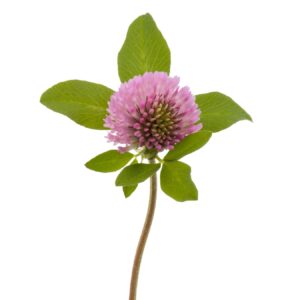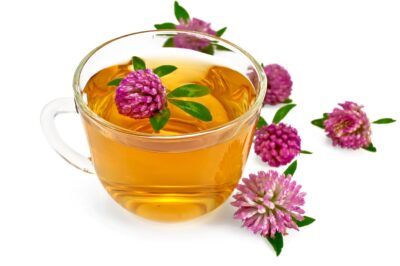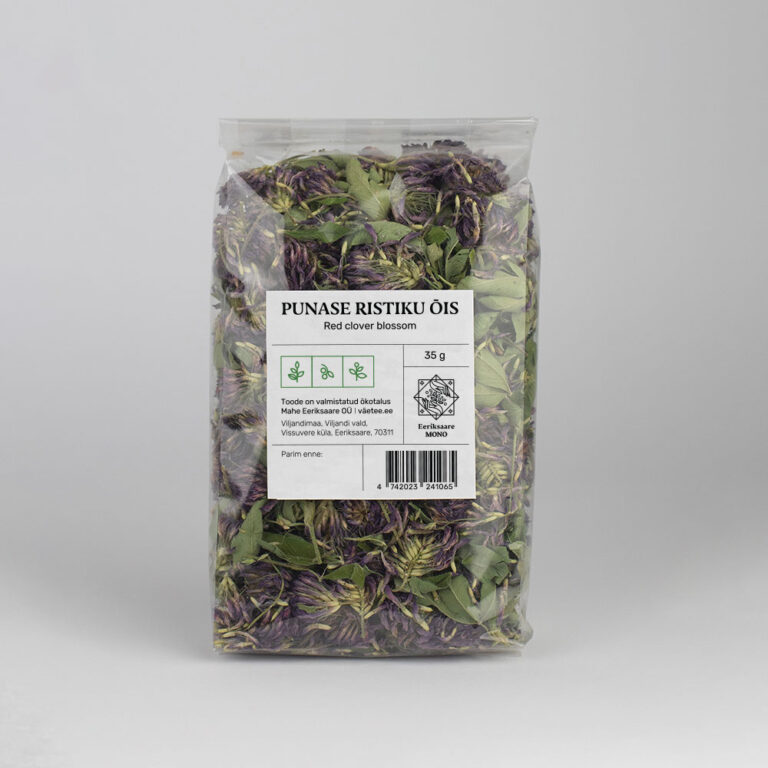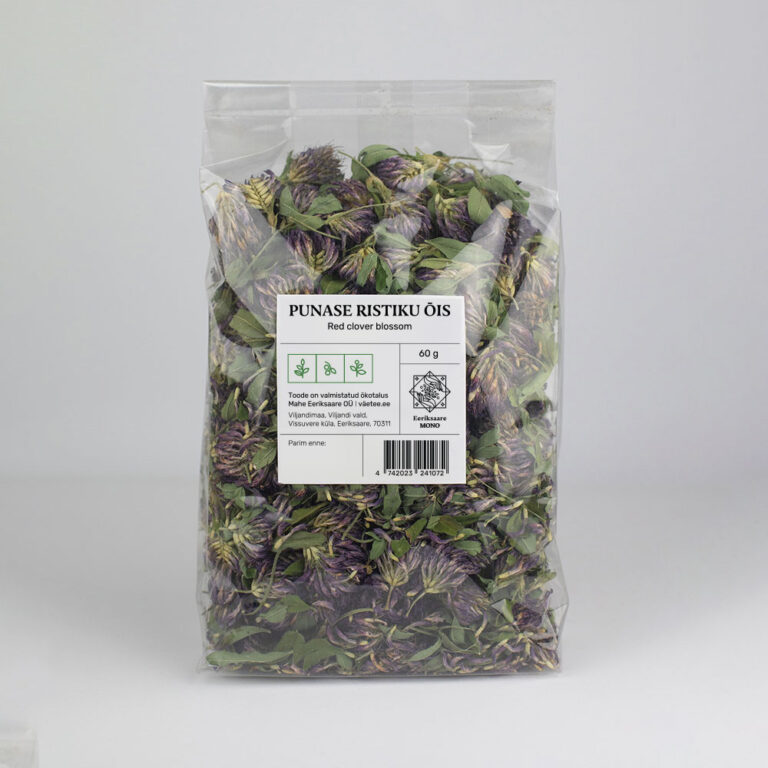Red clover(Trifolium pratense)
 Red clover, also known as field clover or meadow clover, is a valuable medicinal herb that has been used for centuries in traditional herbal medicine due to its versatile health benefits. This perennial plant, growing 20-80 cm tall, belongs to the legume family and features beautiful purplish-red flowers that contain a wealth of beneficial compounds. Red clover thrives in various environments such as dry and wet meadows, shrublands, and pastures in Estonia. It blooms from May to September. The plant is used as animal feed, honey plant, as well as a food and medicinal herb.
Red clover, also known as field clover or meadow clover, is a valuable medicinal herb that has been used for centuries in traditional herbal medicine due to its versatile health benefits. This perennial plant, growing 20-80 cm tall, belongs to the legume family and features beautiful purplish-red flowers that contain a wealth of beneficial compounds. Red clover thrives in various environments such as dry and wet meadows, shrublands, and pastures in Estonia. It blooms from May to September. The plant is used as animal feed, honey plant, as well as a food and medicinal herb.
Red clover is rich in carbohydrates, saponins, vitamins C, B, E, and K, carotenoids, flavonoids, phytoestrogens, coumaric acids, salicylic acid, organic acids, tannins, fatty acids, and trace elements (such as calcium, magnesium, potassium, phosphorus, chromium) as well as essential oils.
For medicinal use, the flowers of the red clover, along with the upper leaves, are harvested. The flowers are collected at the beginning of the plant’s blooming period and dried at a temperature of 60–70°C. It is important to avoid overdrying, as this can cause the medicinal properties of the herb to be lost. In some cases, the herb is also prepared from the root of the plant.
Interesting fact: Red clover has also been used as a food plant. The young shoots were primarily used, much like spinach, in soups, stews, and salads. These young shoots contain 14% sugars, 25% easily digestible proteins, and 5.6% fats. The leaves were also dried, ground into flour, and added to bread flour. In Canada, it is quite common to add dried red clover flower heads to food. In the Caucasus, red clover is fermented for winter storage, similar to how sauerkraut is made.
The health-promoting properties of the red clover:
- Hormonal balance
Red clover contains phytoestrogens (which are present in low amounts in white clover): chemical compounds found in plants that support the body’s hormonal balance and help reduce hot flashes, mood swings, and other symptoms during menopause. - Bone health
The phytoestrogens in red clover may support bone strength, helping to prevent bone density loss. Red clover also contains isoflavones, which slow down the loss of bone mass after menopause. - Anti-inflammatory properties
Red clover is known for its anti-inflammatory properties, which can help relieve chronic inflammation and support joint health. - Circulation and heart support
Red clover promotes healthy circulation and helps lower bad cholesterol levels, supporting heart health. - Detoxifying effects
Red clover helps purify the blood and assists in removing waste products from the body, supporting the function of the liver and kidneys. - Skin benefits
Red clover is useful for relieving skin problems such as eczema and psoriasis. It is often used in natural creams and ointments.
Anthony William, the Medical Medium, writes on his blog that red clover is often considered just a common weed, but it deserves much more recognition. This plant has a generous and nurturing nature, almost as if it truly cares for the person consuming it. Red clover is considered one of the most powerful herbs for supporting the lymphatic system and cleansing lymph fluid. According to William, it may also help in cancer prevention. This generous herb, whose flowers and leaves are both useful, acts as a diuretic and a blood tonic, making it beneficial for those concerned with any blood disorders or diseases, including those caused by liver or pancreas dysfunction leading to toxic blood. Red clover can be turned to in cases of burnout to regain energy and vitality. It helps remineralize the body on a deep level and is one of the best herbs for stimulating weight loss. Read more about red clover on the Medical Medium blog.
Possible uses:
- Tea: Red clover tea, made from its flowers, is mild and relaxing, making it a great choice for daily enjoyment. Red clover tea has been valued for centuries for its soothing, cleansing, and health-supporting properties. Its main ingredient, the red clover flowers, is rich in vitamins, minerals, and natural antioxidants, making this drink a true gift from nature.
- Tincture: in a concentrated form to provide a stronger effect.
- Topical use: ointments and compresses to relieve irritation or inflammation.
How to make red clover tea? 
- Take 1-2 teaspoons of dried red clover flowers.
- Add them to 250 ml of boiling water.
- Leave to infuse for 5-10 minutes.
- Strain and enjoy! If desired, add honey or lemon to taste.
When to consume red clover tea?
- In the morning for energy and balance.
- During the day to support digestion and relieve inflammation.
- In the evening to calm you down and promote better sleep.
Red clover tea is a light, tasty and healthy way to balance your body and improve your well-being. Let nature take care of you – a cup of red clover tea every day can be a step towards a healthier life! Eeriksaare Tea Farm – closeness to nature and wisdom passed down from generation to generation. Eeriksaare Tea Farm is a place where the land, soil, and traditions are honored. Their roots run deep in the local soil, and they feel a strong connection to the unique character of the area. The agricultural knowledge passed down from their grandparents and the old meadows form the foundation of their tea farm—drawing strength and inspiration from here to create flavorful teas. The tea plants grow in lovingly cared-for soil, free from synthetic fertilizers or pesticides. The plants are cultivated and harvested by hand, ensuring the highest quality and natural purity in every leaf. The tea plants they don’t grow themselves are harvested from the ancient forests and bogs of Viljandi County, ensuring that every tea blend carries the power and unique flavor of the local nature. Eeriksaare Tea Farm holds deep respect for their homeland and heritage. They cherish nature and work sustainably, ensuring that their fields and forests remain the same for future generations. Tea Farm is a place where the land, the soil and the traditions are respected. Their roots run deep in the soil of their homeland and they feel a strong connection to the special character of this place. The farming wisdom of their grandparents and the old meadows are the foundation of their teahouse – where they draw strength and inspiration to create delicious teas. Tea plants grow in lovingly tended soil, unencumbered by artificial fertilisers and pesticides. The plants are grown and harvested by hand, ensuring the highest quality and natural purity in every leaf. The tea plants, which they do not grow themselves, are harvested from Viljandi’s pristine forests and bogs. This ensures that each tea blend carries the power and unique taste of the local nature. Eeriksaare Tea Farm honours its homeland and its heritage. They care for nature and work sustainably to ensure that their fields and forests remain the same for future generations.







Reviews
There are no reviews yet.